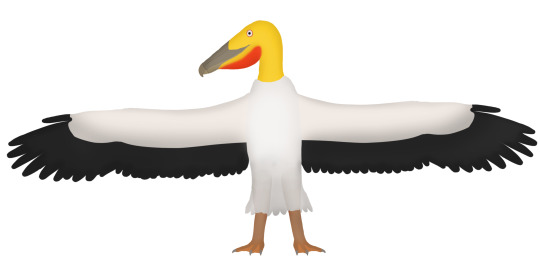#Dyptogyps
Photo

Dyptogyps sp.
Seabird communities have changed significantly 50 million years in the future. The impact that humans caused on the oceans had a major effect on aquatic birds. Seabird diversity decreased at the end of the Quaternary, with some clades such as pelicans and albatrosses going extinct entirely. But by the mid-Telogene, new birds have evolved to fill these niches, and seabird biodiversity is high once again.
Diving-vultures are large and portly birds, with wingspans of up to three meters in large individuals. The genus Dyptogyps ranges along the coasts of South America and western North America. They are characterized by their brightly-colored heads, including throat pouches that take on vivid colorations during the breeding season. As the name implies, these birds are piscivorous, diving for food. Diving-vulture eyes have a thick but transparent nictitating membrane, allowing an individual to see prey and pursue it underwater. Although their ancestors had good senses of smell, diving-vultures lack external nostrils entirely; instead the internal nostrils house salt-removing glands.
19 notes
·
View notes
Text
Peruvian Coast, 50 million years hence

50 million years in the future, the western coast of South America appears largely the same. On land, the coast is still an arid desert, with few things living on it. Offshore, the seas are thriving with fish stocks that have long since recovered from human harvesting. Upwelling caused by the movement of ocean currents continues to make these waters some of the richest in the world.
Many animals of the Peruvian coastline subsist on the fish, such as a swimming species of cat. Pinnipeds and seabirds continue to fish these waters, but they have changed since the Holocene. Some of the pinnipeds in these waters are completely marine. Closer to the shore, marine pigs graze upon coastal seagrass, and large predatory birds prowl the coasts.
Inhabitants of the Peruvian Coast include:
Dyptogyps sp.
Great sea bear
Paractirapax acanthoglossum
Smilopterus celer
South American meerschwein
South American ottercat
5 notes
·
View notes